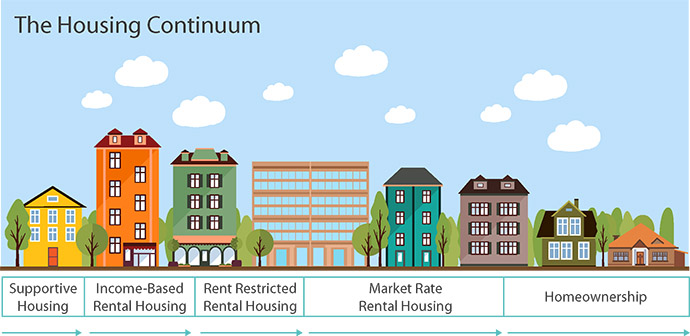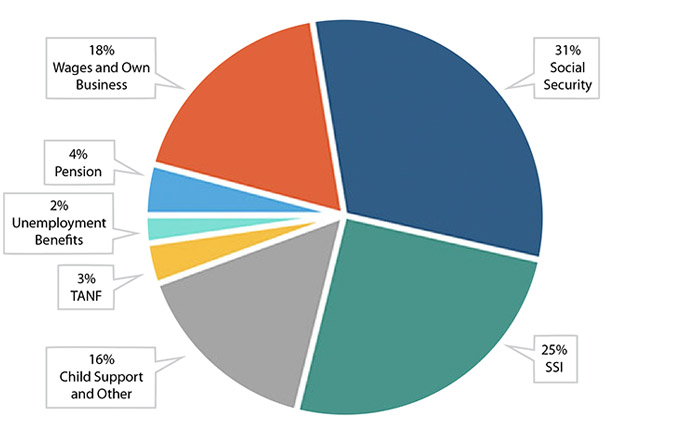Ways Home. Paths Forward.
Home is the hub for living our best, most productive lives.
HASCO provides housing solutions for the people and communities of Snohomish County.
We partner with…
- People who need support to achieve housing stability.
- Communities, to develop and maintain high quality housing for people at all stages of life, keeping families, neighbors and neighborhoods intact.
- Social service organizations helping individuals and families make progress in life.
We connect people with federal and local programs that help with rent, provide affordable housing in places we own and support our tenants with services.
HASCO leads within a network of housing services providers, working toward a future where all Snohomish County residents have good quality housing, and places to call home.
Learn more about what’s “affordable” in Snohomish County.

Solutions and Partnerships
Housing Solutions
HASCO is a housing services provider with a particular focus: reducing the cost of housing for people who sacrifice basic needs to afford a stable place to call home.
We provide a range of solutions for people with a range of incomes. By serving a broad spectrum of housing needs, we generate support for more people and families.
HASCO’s Housing Continuum
Through federal rent subsidies, partnerships with social services programs and our owned properties, HASCO serves residents and supports Snohomish County communities in the following ways.
- Provide long-term housing and financial support for senior citizens and adults with disabilities living on fixed incomes.
- Maintain the integrity of neighborhoods by allowing people to stay in the communities where they work, live and have support systems.
- Provide time-limited housing support to individuals and families working to achieve stability and financial independence.
- Reduce homelessness through programs that provide resources to extremely low-income households, families with children and veterans.
- Create more housing for people and families with average and below average incomes.
Learn more about the growing cost of housing relative to household incomes on our Facing the Future page.

HASCO provides housing for people within each category listed above. All federal funding allocated to HASCO is used for Supportive Housing, Income-Based Rental Housing and related services. Our Fair Market, HASCO Communities and Manufactured Housing Communities generate income we use to develop additional resources and expand housing options.
HASCO Snapshot
Each chart is a short chapter in a much larger story. The numbers give an overview of HASCO’s biggest program and properties.
Chart 1: Housing Vouchers Administered by HASCO
Voucher holders rent from private landlords in the community through seven programs. Each voucher represents one household served.
Number of Vouchers Per Program
(2021)

Total HASCO Vouchers = 4,100
The chart includes HASCO and Partner Programs, where partners provide social services and HASCO provides the housing vouchers.
- FUP – Family Unification Program, including young adult Foster Youth
- HCVs – Housing Choice Vouchers
- NED/M – Three Non-Elderly Disabled and Mainstream programs serving households with an adult under 62 years old with disabilities
- PBVs – Project Based Vouchers
- VASH – Veterans Affairs Supportive Housing
Chart 2: Properties Owned by HASCO
Number of Living Units by Home Type
(2021)

Total HASCO Living Units = 2,439
The chart includes all HASCO’s owned properties.
- Fair Market Rentals – Apartments
- HASCO Communities – Apartments and Townhomes
- Manufactured Housing – HASCO owns three Manufactured Housing Communities where homeowners rent pads.
- Senior & Disabled Units – Subsidized apartment communities for people over 62 and adults with disabilities.
Chart 3: Quantifying Met & Unmet Need
Estimated Qualifying Households vs. Available Assistance from HASCO
(2019)

Of the 77,355 Snohomish County households that qualified for housing assistance when this chart was calculated, federal funding was available to help 6,424 of them—or 8.3%.
Service Partnerships
HASCO partners with other housing services providers to support people and families working through a range of difficult circumstances. Using resources made available through federal funding programs, we provide housing support while our partners provide services that support life progress, including one or more of the following.
- Addiction treatment
- Behavioral health services
- Career and job skills training
- Mental health treatment
We proudly work with the following organizations.
- Catholic Community Services
- Cocoon House
- Compass Health
- DCYF (WA State Department of Children, Youth, and Families)
- Housing Hope
- U.S. Department of Veterans Affairs Seattle Division (VA)
- Vision House
- Volunteers of America
- WorkSource
- YWCA of Seattle/King/Snohomish
Housing Solution Collaborators
HASCO belongs to many nonprofit groups working to address Snohomish County’s housing crisis. Each of these research-based groups identifies and proposes actions to improve one or more components of our housing shortage, particularly for people with average and below average incomes.
- AHA: Alliance for Housing Affordability
- AWHA: Association of Washington Housing Authorities
- CLPHA: Council of Large Public Housing Authorities
- Housing Consortium of Everett and Snohomish County
- PEH: Partnership to End Homelessness
- Pacific Northwest Regional Council of the National Association of Housing and Redevelopment Officials
Solving Snohomish County’s housing crisis will take collaboration among citizens, local and regional governments, businesses and business organizations, our education institutions and a strong collective will.

People We Help
People who qualify for HASCO housing support programs all carry a heavy burden. Cutting expenses and juggling responsibilities often don’t stretch their incomes far enough to afford housing plus basic necessities. Whether making a choice between health insurance and medication, not being able to put quality food on the table or save month to month, it all comes back to basic needs being sacrificed to afford rent.
HASCO works hard to make people who need housing support feel welcome and valued. We’re optimistic because we’ve seen so many people move forward in life once they have a stable home to live in.
Household Snapshots
The Housing Choice Voucher (HCV) Program is the largest program HASCO administers and serves the most people. Program participants are overwhelmingly people on fixed incomes—adults with a certified disability and senior citizens. HCV program participants pay 30% to 40% of their income for rent and utilities; through a voucher system HASCO pays the landlord the difference between the participant’s portion and full rent.
Chart 1: Household Makeup
Most Housing Choice Voucher (HCV) program participants live with one other person. The average household size is 2.2 people. More than two-thirds of HCV households include a senior citizen (age 62 or older), a person with a disability, or a person who is a senior citizen with a medically diagnosed disability.
Household Members in HCV-Supported Homes
(2021)

Chart 2: Household Member Ages
The Housing Choice Voucher program helps people of all ages live in a stable home. Many households include children.
Percent of HCV Participants by Age Group
(2021)

8,582 people receive housing assistance through HASCO’s voucher programs.
Chart 3: Household Income
The average before-tax income for Housing Choice Voucher (HCV) households is $16,238 per year (2019). Two-thirds of the households include a senior citizen (at least 62 years old), a person with a disability or a senior who has a disability. Many in that group rely on Social Security and Supplemental Security (SSI) for their entire income. Only a small percentage of income for voucher holder households comes from Temporary Assistance for Needy Families (TANF).
The following chart shows where HCV household income comes from. Many households have more than one source of income (such as wages plus SSI).
Source of Household Income
(2021)

Chart 4: Veteran Program Household Members
The Veterans Affairs Supportive Housing (VASH) Program provides Housing Choice Vouchers to military veterans. The majority of VASH households include a senior citizen (age 62 and above), a person with a disability or a senior with a diagnosed disability.
Household Members in VASH-Supported Homes
(2021)

454 people receive housing assistance through the VASH program's 325 vouchers.
Chart 5: VASH Household Member Ages
The average Veterans Affairs Supportive Housing (VASH) household includes 1.5 people, meaning that the majority of veterans in this program live alone. Here’s a breakdown of household members by age.
Percent of VASH Participants by Age Group
(2021)

The People Behind the Charts
Home is the hub for living our best, most productive lives. Housing Choice Vouchers (HCV), HASCO’s largest program, help people find and keep their home base—which is often near a needed support system or within a familiar community. Most HCV households include a senior, a person with a diagnosed disability or a senior with a disability; the rest are families and individuals facing extraordinary circumstances. Voucher holders are our neighbors, contributing to neighborhood economies and vitality.
Read what people housed through HASCO say about the difference having a home makes in their lives.

Funding and Economic Impact
HASCO connects people with federal and local programs that help with rent, freeing up household resources for basic needs and forward progress in life.
We administer eight federal rent assistance programs through a streamlined process that ensures equitable treatment to every applicant. Program funds come from three distinct federal agencies.
- U.S. Department of Agriculture (USDA)
- U.S. Department of Housing and Urban Development (HUD)
- U.S. Department of Veterans Affairs (VA)
We partner with local human services providers so participants with transitional needs can have a stable place to live while in the program. HASCO provides participants of specific programs with housing support provided through our federal contracts.
HASCO uses revenue from properties it operates as a landlord to reinvest in the community through building maintenance and renovation, program and participant support and employing HASCO staff.
We are careful stewards of public funds. Whether through a federal program or HASCO owned properties, every dollar HASCO receives benefits Snohomish County. HASCO maintains an A+ rating from S&P Global Ratings.
Chart 1: Total Annual Funds
HASCO manages several different kinds of income.
U.S. government payments for vouchers and housing for seniors and people with disabilities also cover the administrative costs. This includes the Housing Choice Voucher (HCV), Senior and Disabled and Partner Programs.
HASCO earns separate income from other sources, which allows us to purchase, renovate and maintain properties within Snohomish County.
Fiscal Year 2021 Funding Sources

HASCO anticipates receiving a total of $86.8 million in FY 2021.
Chart 2: Annual Expenses
HASCO’s largest expense is for rent and utilities paid to Snohomish County households, including private landlords serving program participants.
Fiscal Year 2021 Fund Uses

HASCO anticipates $78.9 million in program and operational expenses in FY 2021.
In addition to the expenses listed in this chart, HASCO maintains a reserve fund. With over 2,000 housing units in our owned properties, we plan ahead for renovations. We continually look for opportunities to purchase properties that expand housing options for the people of Snohomish County.
